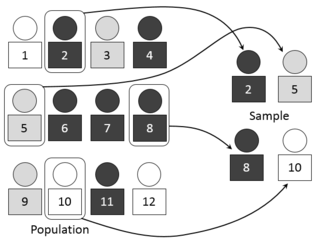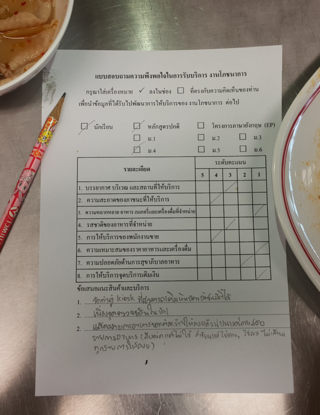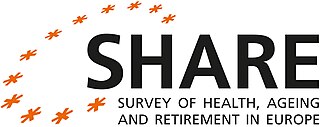Related Research Articles
In statistics, survey sampling describes the process of selecting a sample of elements from a target population to conduct a survey. The term "survey" may refer to many different types or techniques of observation. In survey sampling it most often involves a questionnaire used to measure the characteristics and/or attitudes of people. Different ways of contacting members of a sample once they have been selected is the subject of survey data collection. The purpose of sampling is to reduce the cost and/or the amount of work that it would take to survey the entire target population. A survey that measures the entire target population is called a census. A sample refers to a group or section of a population from which information is to be obtained.

In statistics, quality assurance, and survey methodology, sampling is the selection of a subset or a statistical sample of individuals from within a statistical population to estimate characteristics of the whole population. Statisticians attempt to collect samples that are representative of the population. Sampling has lower costs and faster data collection compared to recording data from the entire population, and thus, it can provide insights in cases where it is infeasible to measure an entire population.
Survey methodology is "the study of survey methods". As a field of applied statistics concentrating on human-research surveys, survey methodology studies the sampling of individual units from a population and associated techniques of survey data collection, such as questionnaire construction and methods for improving the number and accuracy of responses to surveys. Survey methodology targets instruments or procedures that ask one or more questions that may or may not be answered.

The American Community Survey (ACS) is an annual demographics survey program conducted by the U.S. Census Bureau. It regularly gathers information previously contained only in the long form of the decennial census, including ancestry, citizenship, educational attainment, income, language proficiency, migration, disability, employment, and housing characteristics. These data are used by many public-sector, private-sector, and not-for-profit stakeholders to allocate funding, track shifting demographics, plan for emergencies, and learn about local communities.

The Survey of Income and Program Participation (SIPP) is a statistical survey conducted by the U.S. Census Bureau. The SIPP is designed to provide accurate and comprehensive information about the incomes of American individuals and households and their participation in income transfer programs.

A questionnaire is a research instrument that consists of a set of questions for the purpose of gathering information from respondents through survey or statistical study. A research questionnaire is typically a mix of close-ended questions and open-ended questions. Open-ended, long-term questions offer the respondent the ability to elaborate on their thoughts. The Research questionnaire was developed by the Statistical Society of London in 1838.
The Consumer Expenditure Survey is a Bureau of Labor Statistics (BLS) household survey that collects information on the buying habits of U.S. consumers. The program consists of two components — the Interview Survey and the Diary Survey — each with its own sample. The surveys collect data on expenditures, income, and consumer unit characteristics. In May 2020, the American Association for Public Opinion Research recognized the CE program with its 2020 Policy Impact Award, for joint work by the BLS -- including CE and the Division of Price and Index Number Research -- and the Census Bureau on the Supplemental Poverty thresholds and measure, and the essential contributions these data products have made to the understanding, discussion, and advancement of public policy related to the alleviation of poverty in the United States.
The National Longitudinal Surveys (NLS) are a set of surveys sponsored by the Bureau of Labor Statistics (BLS) of the U.S. Department of Labor. These surveys have gathered information at multiple points in time on the labor market experiences and other significant life events of several groups of men and women. Each of the NLS samples consists of several thousand individuals, many of whom have been surveyed over several decades.

The Survey of Health, Ageing and Retirement in Europe (SHARE) is a multidisciplinary and cross-national panel database of micro data on health, socio-economic status and social and family networks. In seven survey waves to date, SHARE has conducted approximately 380,000 interviews with about 140,000 individuals aged 50 and over. The survey covers 28 European countries and Israel.
The English Longitudinal Study of Ageing (ELSA) is a longitudinal study that collects multidisciplinary data from a representative sample of the English population aged 50 and older to look at all aspects of aging in England.

In research of human subjects, a survey is a list of questions aimed for extracting specific data from a particular group of people. Surveys may be conducted by phone, mail, via the internet, and also at street corners or in malls. Surveys are used to gather or gain knowledge in fields such as social research and demography.
The Study on global AGEing and adult health (SAGE) is run by the World Health Organization. An objective for SAGE is to compile comprehensive longitudinal data on the health and well-being of adult populations and the ageing process across different countries, through primary data collection, secondary data analysis and cross-study collaborations.

China Family Panel Studies is a nationally representative, biennial longitudinal general social survey project designed to document changes in Chinese society, economy, population, education, and health. The CFPS was launched in 2010 by the Institute of Social Science Survey (ISSS) of Peking University, China. The data were collected at the individual, family, and community levels and are targeted for use in academic research and public policy analysis. CFPS focuses on the economic and non-economic well-being of the Chinese people, and covers topics such as economic activities, educational attainment, family relationships and dynamics, migration, and physical and mental health. The themes cover social, economic, education, health and so forth.
SHARE-Israel is the Israeli component of the Survey of Health, Ageing and Retirement in Europe, a multidisciplinary and cross-national panel database of micro data on health, socio-economic status as well as social and family networks of individuals aged 50 or over.
The marketing research process is a six-step process involving the definition of the problem being studied upon, determining what approach to take, formulation of research design, field work entailed, data preparation and analysis, and the generation of reports, how to present these reports, and overall, how the task can be accomplished.
The Panel Study of Income Dynamics (PSID) is a longitudinal panel survey of American families, conducted by the Survey Research Center at the University of Michigan.
Mode effect is a broad term referring to a phenomenon where a particular survey administration mode causes different data to be collected. For example, when asking a question using two different modes, responses to one mode may be significantly and substantially different from responses given in the other mode. Mode effects are a methodological artifact, limiting the ability to compare results from different modes of collection.
With the application of probability sampling in the 1930s, surveys became a standard tool for empirical research in social sciences, marketing, and official statistics. The methods involved in survey data collection are any of a number of ways in which data can be collected for a statistical survey. These are methods that are used to collect information from a sample of individuals in a systematic way. First there was the change from traditional paper-and-pencil interviewing (PAPI) to computer-assisted interviewing (CAI). Now, face-to-face surveys (CAPI), telephone surveys (CATI), and mail surveys are increasingly replaced by web surveys. In addition, remote interviewers could possibly keep the respondent engaged while reducing cost as compared to in-person interviewers.
The National Health Interview Survey (NHIS) is an annual, cross-sectional survey intended to provide nationally representative estimates on a wide range of health status and utilization measures among the nonmilitary, noninstitutionalized population of the United States. Each annual data set can be used to examine the disease burden and access to care that individuals and families are currently experiencing in the United States.
The National Campus Climate Survey (NCCS) is a service offered to institutions of higher education in the United States who would like to better understand and improve their campus climate with regards to sexual assault and related topics. The study is designed to:
- Meet all state and federal requirements for the conduct of sexual assault surveys.
- Provide a scientifically rigorous survey instrument to help schools learn about the campus climate concerning sexual misconduct.
- Provide varying survey implementation tiers to match institutions' varying needs for defensible data.
- Provide a benchmarking tool to allow institutions to compare their results against other participating institutions, and where possible, peer groups.
References
- ↑ "Home". hints.cancer.gov.
- ↑ Hesse, B.W., Moser, R.P., Rutten, L.J.F., & Kreps, G.L. (2006). The Health Information National Trends Survey: Research From the Baseline. Journal of Health Communication, 11, 7-16
- ↑ Nelson, D., Kreps, G., Hesse, B.W., Croyle, R., Willis, G., Arora, N.K., Rimer B., Viswanath, K., Weinstein, N., & Alden, S. (2004). The Health Information National Trends Survey (HINTS): Development, Design, and Dissemination. Journal of Health Communication, 9(5), 443-460
- ↑ Hesse, B.W., Nelson, D.E., Kreps, G.L., Croyle, R.T., Arora, N.K., Rimer, B.K., & Viswanath, K. (2005). Trust and Sources of Health Information: Findings from the First Health Information National Trends Survey. Archives of Internal Medicine, 165, 2618-2624
- ↑ Arora, N.K., Hesse, B.W., Rimer, B.K., Viswanath, K., Clayman, M.L., & Croyle, R.T. (2007). Frustrated and Confused: The American Public Rates its Cancer-Related Information Seeking Experiences. Journal of General Internal Medicine, 23(3), 223-228
- ↑ "CDC - BRFSS". www.cdc.gov. January 9, 2024.
- ↑ "NHIS - National Health Interview Survey". www.cdc.gov. March 12, 2024.
- ↑ View the 2003 survey instruments: English here and Spanish here
- ↑ View the final report
- ↑ View the 2005 survey instruments: English here and Spanish here
- ↑ View the 2005 Final Report
- ↑ View final versions of the annotated survey instruments: HINTS 2008 Mail Instrument here, English CATI here, Spanish CATI here
- ↑ "Journal". Archived from the original on 2013-05-02. Retrieved 2008-12-29.
- ↑ Journal of Health Communication
- ↑ "Data Users Handbook" (PDF).
- ↑ "Health Information National Trends Survey | HINTS". hints.cancer.gov.
- ↑ "Sun safety brief" (PDF).
- ↑ "HPV brief" (PDF).
- ↑ "Information-seeking behavior brief" (PDF).
- ↑ "HINTS brochure" (PDF).
- ↑ "English fact sheet" (PDF).
- ↑ "Spanish fact sheet" (PDF).
- ↑ "Data Collection Schedule | HINTS". hints.cancer.gov.